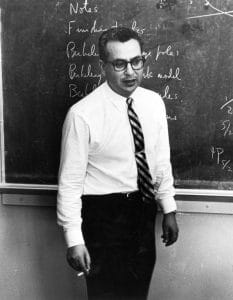Born in New York to immigrant parents, Gell-Mann wanted to study archaeology or natural history; he also enjoyed linguistics (he spoke several languages) and ornithology. But, to please his father, he studied physics instead, even though physics was “the only course in which I did badly in high school, and hated it.” He earned his bachelor’s degree in physics from Yale in 1948, and his PhD in physics from Massachusetts Institute of Technology in 1951. After moving up from job to job after school, in 1955 he was hired by the California Institute of Technology, where he stayed until his 1993 retirement. Meanwhile, in 1958, Gell-Mann was working with Caltech theoretical physicist Dr. Richard Feynman. The problem of the day: “atom smashers” (particle accelerators) were breaking apart atoms into smaller and smaller particles. And that’s before you add in the particles that were streaming in from space via “cosmic rays” — muons, protons, antiprotons, alpha particles, pions, electrons, positrons, and neutrons.

Gell-Mann brought order to the chaos, first with the cosmic ray particles. Classifying these particles led him to propose that a quantum property called strangeness would be conserved by the strong and the electromagnetic interactions, but not by the weak interactions. That led to Gell-Mann’s “eightfold way” (an allusion to the Buddhist Eightfold Path to enlightenment) — an organizational scheme for hadrons. Hadrons make up most of the mass of matter; the proton and the neutron are the two main hadrons. But what are hadrons made of? In 1964, Gell-Mann postulated the existence of quarks; he coined the name for this fundamental constituent of matter. Then he came up with an organizational structure for them, too: it’s not just that there are quarks, but there are six “flavors” of quarks — and six types of leptons, and more bosons than you can shake an electron at. Quarks can’t be seen individually, or be dislodged from the larger particles they are built into. But later experiments confirmed the existence of quarks, and these objects now form the basis for our physical understanding of the universe. “Murray Gell-Mann was a seminal figure in the history of physics,” says Caltech president Thomas Rosenbaum, a professor of physics himself. “Murray helped define the approaches of generations of scientists.” Gell-Mann also studied the issues of complexity in biology, ecology, sociology, and computer science, and co-founded the Santa Fe Institute in New Mexico in 1984 to study such complex systems; he wrote The Quark and the Jaguar (1994) to present his ideas on simplicity and complexity to a general readership.
Gell-Mann bringing order to particle physics led to him being awarded the Nobel Prize in Physics in 1969. “Our work is a delightful game,” he said at the Nobel ceremonies. “I am frequently astonished that it so often results in correct predictions of experimental results.” Despite “hating” physics as a teen, “after a while I got to like it. And I found that my father was right, in fact, uncharacteristically, he was quite right. Quantum mechanics and relativity were marvelous.” Dr. Gell-Mann died at his New Mexico home on May 24. He was 89.
